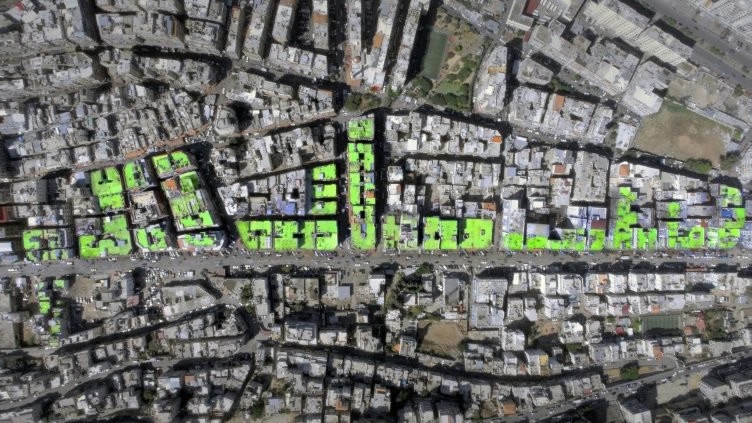
Culture
17:34, 21-Oct-2017
Art brings 'peace' to battle-scarred Lebanon districts
CGTN

From the street below it's easy to miss the workers daubing rooftops as part of an ambitious art project in two battle-scarred neighborhoods of Lebanese city of Tripoli.
But the Ashekman street art duo behind the project says that once they're done, the pistachio-green rooftops they are painting will spell out the word "salam" - Arabic for "peace" - on a scale visible from space.
The project, three years in the making, is the brainchild of 34-year-old twins Mohamed and Omar Kabbani.
They researched and rejected multiple locations in their native Lebanon before settling on Tripoli.
They chose a site spanning the Bab al-Tebbaneh and Jabal Mohsen neighborhoods, which have fought successive rounds of armed clashes in recent years.
"We jumped from one location to another and finally we decided to do it here in Tripoli, specifically in Bab al-Tebbaneh and Jabal Mohsen, an area that has been in conflict," said Omar Kabbani.
"We're painting the word 'salam' across 85 building rooftops over 1.3 kilometers... to convey that people here are peaceful," he said.
"And Lebanon in general, we want peace."

AFP Photo
AFP Photo
From bullets to brushes
Peace has been elusive in Sunni-majority Bab al-Tebbaneh and the adjacent Alawite-majority Jabal Mohsen.
Fighters from the two areas have battled each other periodically for decades, and the war in neighboring Syria, pitting a Sunni-dominated uprising against Alawite President Bashar al-Assad, has further stirred existing enmities.
The clashes have gouged hundreds of bullet holes into building facades, while mortar fire has blasted through walls, rendering some homes uninhabitable.
Fighting between the neighborhoods has eased in the last two years, but photos of those killed in the most recent violence remain plastered across both areas.
Ashekman's project runs on either side of the infamous Syria Street separating the two neighborhoods. The duo hired workers from across the divide to help them complete the project.
"All of the workers live here in the neighborhood, they lived the conflict, some of them got shot," Omar Kabbani said.
"Two years ago they were hiding from bullets... now they're painting their rooftops proudly."
The brothers are sensitive to the observation that their project does little to address the most obvious scars of fighting or the area's desperate poverty, often identified as a catalyst for the violence.
They say they chose paint that will seal rooftops against rain and reflect ultra-violet rays, cooling the homes below.
And in order to paint the rooftops, they had to negotiate with residents and often had to clear large amounts of trash and debris.
"It took us around 10 days just to remove all the garbage on the rooftops," said Kabbani.
"With the garbage came a couple of rats, and we fought with some rats. It wasn't an easy task," he said, laughing.

AFP Photo
AFP Photo
'Peace, a great word'
Walid Abu Heit, 29, joined the project as a painter after hearing about it from March, a Lebanese NGO that has worked on reconciliation and rehabilitation in the rival neighbourhoods.
He was born in Bab al-Tebbaneh and worked at a dairy, but lost his job after violence erupted.
"It was very difficult when fighting broke out," he said.
"Darkness engulfed the neighbourhood. People stopped coming here."
He and other workers lugged heavy tubs of paint up seven floors and began plastering a roof with the fluorescent green, which flecked his hands and boots.
"It's an amazing project," he said, smiling and shading his eyes from the blazing sun.
"The word peace, it's a great word... we haven't seen it for a long time, now we're seeing it again."
Source(s): AFP

SITEMAP
Copyright © 2018 CGTN. Beijing ICP prepared NO.16065310-3
Copyright © 2018 CGTN. Beijing ICP prepared NO.16065310-3